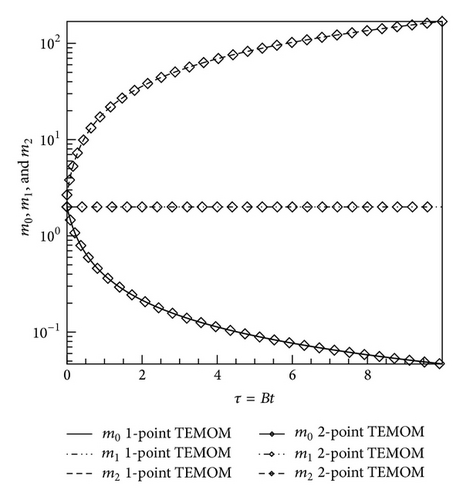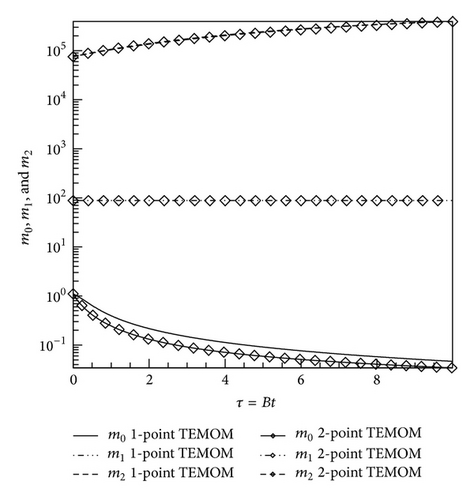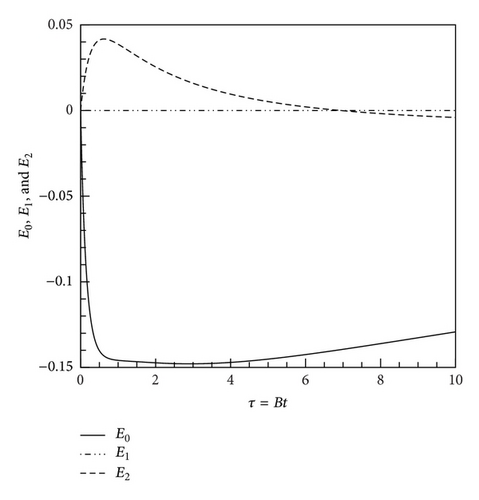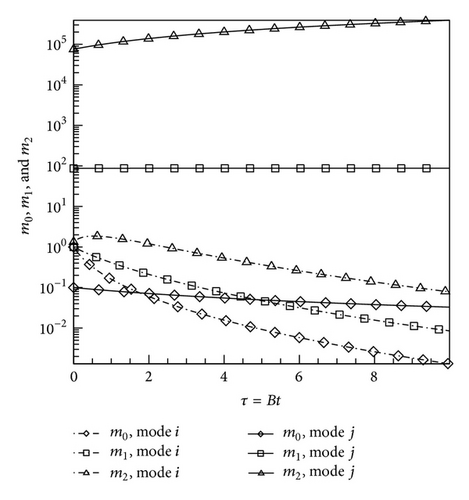A New Method of Moments for the Bimodal Particle System in the Stokes Regime
Abstract
The current paper studied the particle system in the Stokes regime with a bimodal distribution. In such a system, the particles tend to congregate around two major sizes. In order to investigate this system, the conventional method of moments (MOM) should be extended to include the interaction between different particle clusters. The closure problem for MOM arises and can be solved by a multipoint Taylor-expansion technique. The exact expression is deduced to include the size effect between different particle clusters. The collision effects between different modals could also be modeled. The new model was simply tested and proved to be effective to treat the bimodal system. The results showed that, for single-modal particle system, the results from new model were the same as those from TEMOM. However, for the bimodal particle system, there was a distinct difference between the two models, especially for the zero-order moment. The current model generated fewer particles than TEMOM. The maximum deviation reached about 15% for m0 and 4% for m2. The detailed distribution of each submodal could also be investigated through current model.
1. Introduction
The particulate matter has become one of the most dangerous pollutants to the atmospheric environment and the health of human beings. It will reduce the visibility of the atmosphere and cause the traffic crowding and serious accidents. The fine particles (PM2.5) will also be breathed into the bronchus of human beings, followed by several kinds of respiratory diseases. The lungs will absorb the fine particles and cardiovascular disease will come into being [1]. However, the mechanism of the generation and evolution of the particulate matter still remains to be clarified. Hence, it has both theoretical and realistic senses to study the dynamics of the particulate matter.
Previous study on the aerosol dynamics usually supposes that the particle system is monodispersed (i.e., the system has only one scale) or multidispersed (i.e., the system has multiscales) but is in a log-normal distribution in size [2]. Such kinds of assumptions will greatly simplify the problems, and a series of approximate or precise solutions will be obtained. However, these assumptions are based on the experimental measurement and cannot be applied to all the cases. There is another type of particle size distribution, namely, bimodal or multimodal distribution. For example, the newborn particles together with the background particles compose the bimodal distribution system. Furthermore, the newborn particles may also exhibit a multimodal or bimodal distribution [3]. Pugatshova et al. [4] and Lonati et al. [5] measured the particulate matter in the urban on-road atmosphere in different cities and times. The multimodal distribution was observed. At this time, unacceptable error may appear using mono-dispersed or log-normal assumption.
Take the bimodal system, for example: the particles gather around two independent particle sizes. In order to study such a system, the particle size distribution should be separated into two sub-PSDs [6]. The dynamics of the system may be obtained according to the two subparticle clusters. Under this description, the governing equations of the particle system should be modified to represent the additional coagulation effect [7]; that is, the collision of particles is artificially separated into two kinds: internal coagulation and external coagulation. Because the typical particle diameter of the bimodal system is 5 nm to 2.5 μm, which means that particles lie in different dynamic regimes (free molecular regime, transition regime and continuum regime), the coagulation in such a wide range should also be treated separately. The current study will focus on the continuum (Stokes) regime.
Generally, the particle balance equation (PBE) governs the detailed evolution process of PSD and can be numerically solved. However, because of its huge computation resource to solve the PBE directly, the method of moment (MOM) [2, 8, 9] is often taken into account as an alternation. It takes several moments of PSD in particle volume space and converts PBE into moment equations. Each moment has its physical meaning: zero-order moment represents the number concentration, first-order moment represents the volume concentration, and second-order moment is related to the polydispersity. Although MOM cannot directly give out the evolution of specific PSD, it can obtain the statistical characteristics of particle system and the calculation during this procedure reduces to an acceptable level. As a matter of fact, MOM is widely used in the research of aerosol dynamics for its simplicity and low computational cost.
One limitation of MOM is the closure problem due to the coagulation term in PBE. When PBE is converted into moment equations, the coagulation term will be transformed into fractional moments, which cannot be explicitly expressed and mathematical models should be introduced into MOM to solve this problem, the so-called closure problem. There are typically three kinds of methods: predetermined PSD [2], quadrature method of moment (QMOM) [10], and Taylor-expansion method of moment (TEMOM) [11]. The first class often supposes that the PSD is a log-normal distribution, and the coagulation term can be directly determined. It can only be applied to the log-normal distributed particle system. QMOM utilizes the Gaussian quadrature method to evaluate the coagulation term in the moment equations. The pre-determined PSD is not necessary, but the computation is easy to diverge. TEMOM expands the nonlinear term in the collision kernel using the Taylor expansion. Finally, the coagulation term can be expressed as a linear combination of different moments. TEMOM has its superiority on its easy expression, high precision, and low computational cost. It is widely used in the research of the aerosol dynamics [12–15].
However, using TEMOM to study the bimodal system has some problems. TEMOM expands the collision kernel function at the average diameter u0. For the internal collision, there is no problem, but, for the external collision in bimodal system, this expansion should be extended. For a typical bimodal system, there are two clusters of particles with different diameters, and the total numbers of particles in each cluster are also different. This fact will contribute to the fact that the average diameter of the whole system may lie around the first mode or the second mode or even the mid place of the two modes. If the external collision term also expands at the average diameter of the system, additional error will decrease the accuracy of the simulation. In TEMOM, the convergent region is (0, 2u0) [16], while, for bimodal system, one mode may lie outside this region if both modes expand at the same point. This possibility may lead to the divergence of the calculation.
Hence, the Taylor-expansion method of moments should be developed to be applied to the bimodal particle system to improve the accuracy and the stability. The current research will focus on the multipoint Taylor-expansion method of moments, and the Stokes regime is preferred for ease.
2. Mathematical Theories
The exact expressions of the coefficients in D0, D1, D2, E1, and E2 are listed in the appendix.
3. Tests and Discussion
In order to verify the deduction, both theoretical and numerical validations are performed, respectively.
Substitute D0, D1, D2, E1, and E2 into (5), and set u1 = u2 = m1/m0, r = 1. The right side of new equation just equals 4 times of (9), which is consistent with the theoretical equation (12).
For Case I, , , and [8], which represents a monomodal system and the PSD is separated into two equal sub-PSDs. For Case II, , and and , , and , which represents a bimodal system consisting of two log-normal sub-PSDs.
Figure 1 shows the results of Case I for both single point TEMOM and multipoint TEMOM. From the figure, a good agreement is obtained. This is because the particle system is, in the final analysis, a mono-modal system. The consistency between two methods is just as the same as the theoretical analysis at the beginning of this paragraph.

Figure 2 shows the results of Case II for both single point TEMOM and multi point TEMOM. From the figure, an obvious deviation is found. It shows that, for a typical bimodal system, the particle size difference between different models can not be neglected. The value for multipoint TEMOM is always smaller than that for TEMOM especially for m0. This means that the original TEMOM model will underestimate the coagulation effect for the particle number concentration (m0). Another interesting phenomenon is that m1 is the same for both of the two models. The reason is that m1 physically represents the volume fraction of particles. The particle collision (coagulation) will not change the total volume or the mass of particles. Hence, m1 is a constant from the beginning to the end.


Figure 4 shows the different moments in modes i and j using the technique proposed in current paper. According to the figure, an obvious reduction is found for each moment mk in mode i, which means that the coagulation will lead to the decrease of m0 (particle number concentration) and m1 (particle volume fraction). Particularly the volume fraction of particles, m1, no longer keeps a constant because of the external collision with particles in mode j and the new birth of bigger particles. For particles in mode j, the internal coagulation in mode j will lead to the decrease of m0, while the external coagulation between mode i and mode j will take no effect on m0. As a result, the slope of curve is flatter than that in Figure 2. However, m1 and m2 are comparable with those in Figure 2, because these two parameters are related to the particle volume tightly. The average volume of particle in mode j is much bigger than that in mode i, according to the initial condition. In general, such a result indicates the importance of current technique, giving more accurate result and more detail for the complex bimodal particle system.

4. Conclusions
The current research showed a multipoint Taylor-expansion method of moments for the bimodal particle system in the Stokes regime. A theoretical deduction was performed and brief results are given. Both theoretical validation and numerical tests are implemented. The results show that, for a single-modal system, there is no difference between the two methods. However, for a bimodal system, although the evolution of moments has the same tendency, there is obvious deviation between the two methods. For the case investigated in current paper, the maximum deviation for m0 is about 15% and 4% for m2. Each moment mk in mode i will decrease. The technique proposed in this paper will bring in the accuracy and details of particles. This method can be further extended to the multi-modal system
Conflict of Interests
The authors declare that there is no conflict of interests regarding the publication of this paper.
Acknowledgments
The authors gratefully acknowledges the financial support from the National Natural Science Foundation of China under Grant no. 11302070, the National Basic Research Program of China (973 Program) under Grant no. 2010CB227102.




